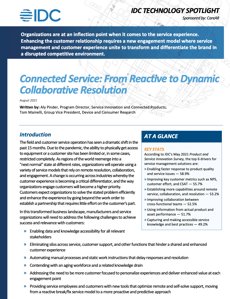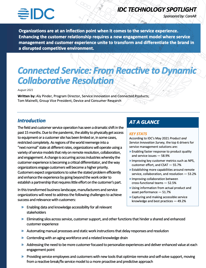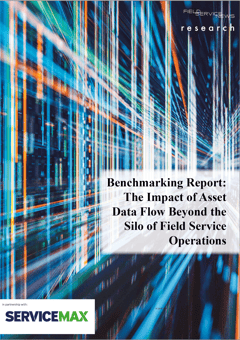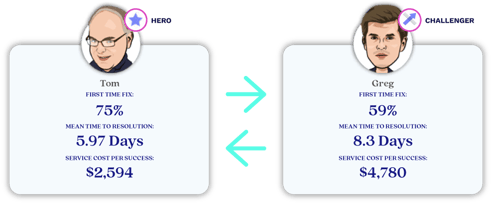Organizations are at an inflection point when it comes to the service experience. In this new series of excerpts from a recent IDC white paper, sponsored by CareAR and now available at Field Service News, we discuss how service organisations can...
ARCHIVE FOR THE ‘features’ CATEGORY
Jan 28, 2022 • Features • White Paper • Digital Transformation • Data Management • customer experience • CareAR
Organizations are at an inflection point when it comes to the service experience. In this new series of excerpts from a recent IDC white paper, sponsored by CareAR and now available at Field Service News, we discuss how service organisations can enhance customer relationships using a new engagement model where service management and customer experience unite to transform and differentiate the brand in a disrupted competitive environment.

This feature is just one short excerpt from a recent white paper published by CareAR.
www.fieldservicenews.com subscribers can read the full white paper now by hitting the button below.
If you are yet to subscribe you can do so for free by hitting the button and registering for our complimentary subscription tier FSN Standard on a dedicated page that provides you instant access to this white paper PLUS you will also be able to access our monthly selection of premium resources as soo as you are registered.

Data usage note: By accessing this content you consent to the contact details submitted when you registered as a subscriber to fieldservicenews.com to be shared with the listed sponsor of this premium content CareAR who may contact you for legitimate business reasons to discuss the content of this white paper, as per the terms and conditions of your subscription agreement which you opted into in line with GDPR regulations and is an ongoing condition of subscription.
The field and customer service operation has seen a dramatic shift in the past 15 months. Due to the pandemic, the ability to physically get access to equipment or a customer site has been limited or, in some cases, restricted completely. As regions of the world reemerge into a "next normal" state at different rates, organizations will operate using a variety of service models that rely on remote resolution, collaboration, and engagement. A change is occurring across industries whereby the customer experience is becoming a critical differentiator, and the way organizations engage customers will become a higher priority. Customers expect organizations to solve the stated problem efficiently and enhance the experience by going beyond the work order to establish a partnership that requires little effort on the customer's part.
In this transformed business landscape, manufacturers and service organizations will need to address the following challenges to achieve success and relevance with customers:
-
» Enabling data and knowledge accessibility for all relevant stakeholders
-
» Eliminating silos across service, customer support, and other functions that hinder a shared and enhanced customer experience
-
» Automating manual processes and static work instructions that delay responses and resolution
-
» Contending with an aging workforce and a related knowledge drain
-
» Addressing the need to be more customer focused to personalize experiences and deliver enhanced value at each engagement point
-
» Providing service employees and customers with new tools that optimize remote and self-solve support, moving from a reactive break/fix service model to a more proactive and predictive approach
KEY STATS
According to IDC's May 2021 Product and Service Innovation Survey, the top 6 drivers for service management solutions are:
-
» Enabling faster response to product quality and service issues — 58.9%
-
» Improving key customer metrics such as NPS, customer effort, and CSAT — 55.7%
-
» Establishing more capabilities around remote service, collaboration, and resolution — 53.2%
-
» Improving collaboration between cross-functional teams — 52.5%
-
» Using information from actual product and asset performance — 51.7%
-
» Capturing and making accessible service knowledge and best practices — 49.2%
Watch out for the next feature next week where we discuss some of the top business priorities for manufacturers and service organizations in this "next normal" environment.
Field Service News subscribers can access the full white paper sponsored by CareAR and written by Ali Pinder, Program Director, Service Innovation and Connected Products at IDC, and Tom Mainelli, IDC's Group Vice President, Device and Consumer Research, by clicking on the button below.

This feature is just one short excerpt from a recent white paper we published in partnership with Exel Computer Systems..
www.fieldservicenews.com subscribers can read the full white paper now by hitting the button below.
If you are yet to subscribe you can do so for free by hitting the button and registering for our complimentary subscription tier FSN Standard on a dedicated page that provides you instant access to this white paper PLUS you will also be able to access our monthly selection of premium resources as soo as you are registered.
 Data usage note: By accessing this content you consent to the contact details submitted when you registered as a subscriber to fieldservicenews.com to be shared with the listed sponsor of this premium content CareAR who may contact you for legitimate business reasons to discuss the content of this white paper, as per the terms and conditions of your subscription agreement which you opted into in line with GDPR regulations and is an ongoing condition of subscription.
Data usage note: By accessing this content you consent to the contact details submitted when you registered as a subscriber to fieldservicenews.com to be shared with the listed sponsor of this premium content CareAR who may contact you for legitimate business reasons to discuss the content of this white paper, as per the terms and conditions of your subscription agreement which you opted into in line with GDPR regulations and is an ongoing condition of subscription.
Further Reading:
- Read more about Digital Transformation @ www.fieldservicenews.com/digital-transformation
- Read more about Customer Experience @ www.fieldservicenews.com/customer-experience
- Learn more about CareAR @ carear.com
- Follow CareAR on Twitter @ twitter.com/carear_com
- Connect with CareAR on LinkedIn @ www.linkedin.com/carear/
Jan 27, 2022 • Features • Digital Transformation • IoT • servicemax • Asset Data • amit jain
Kris Oldland, Editor-in-Chief, Field Service News is joined by Amit Jain, Chief Product Officer, ServiceMax as the two discuss the role of asset data in anticipation of a major research study undertaken by Field Service News Research in partnership...
Kris Oldland, Editor-in-Chief, Field Service News is joined by Amit Jain, Chief Product Officer, ServiceMax as the two discuss the role of asset data in anticipation of a major research study undertaken by Field Service News Research in partnership with ServiceMax.
In this excerpt Jain outlines why he believes there are barriers in many organisations preventing the free flow of asset data across different business units and how these barriers can be overcome.
If you are an FSN Premium subscriber you can access the full interview now on the button below. Alternatively, if you are yet to subscribe or are on our forever-free subscription you can join FSN Premium on the button below and get full access to the entire FSN Premium resource library.
Read the Executive Briefing Report based on the findings of the latest Field Service News Research Project:
 If you are a Field Service News subscriber on either our free-forever FSN Standard subscription tier or our Premium Subscription tier you can access the full 18-page report written by Field Service News, Editor-in-Chief, Kris Oldland that offers in-depth analysis of the research project now on the button below.
If you are a Field Service News subscriber on either our free-forever FSN Standard subscription tier or our Premium Subscription tier you can access the full 18-page report written by Field Service News, Editor-in-Chief, Kris Oldland that offers in-depth analysis of the research project now on the button below.
If you are not yet a subscriber to Field Service News but would like to subscribe and gain access to this report instantly, click the button to visit a dedicated registration page for our complimentary sponsored subscription tier and that will give you instant access to this paper and a number of other assets currently available to subscribers on this tier
 Data usage note: By accessing this content you consent to the contact details submitted when you registered as a subscriber to fieldservicenews.com to be shared with the listed sponsor of this premium content, ServiceMax who may contact you for legitimate business reasons to discuss the content of this study.
Data usage note: By accessing this content you consent to the contact details submitted when you registered as a subscriber to fieldservicenews.com to be shared with the listed sponsor of this premium content, ServiceMax who may contact you for legitimate business reasons to discuss the content of this study.
Jan 25, 2022 • Features • Digital Transformation • IoT • Asset Data
Kris Oldland, Editor-in-Chief, Field Service News is joined by Amit Jain, Chief Product Officer, ServiceMax as the two discuss the role of asset data in anticipation of a major research study undertaken by Field Service News Research in partnership...
Kris Oldland, Editor-in-Chief, Field Service News is joined by Amit Jain, Chief Product Officer, ServiceMax as the two discuss the role of asset data in anticipation of a major research study undertaken by Field Service News Research in partnership with ServiceMax.
In this excerpt from the full discussion, the two discuss how asset data can provide a compelling and important tale of the full history of the assets both on the individual basis as well as across the install base - and why this information is critical for effective field service operations.
If you are an FSN Premium subscriber you can access the full interview now on the button below. Alternatively, if you are yet to subscribe or are on our forever-free subscription you can join FSN Premium on the button below and get full access to the entire FSN Premium resource library.
Read the Executive Briefing Report based on the findings of the latest Field Service News Research Project:
 If you are a Field Service News subscriber on either our free-forever FSN Standard subscription tier or our Premium Subscription tier you can access the full 18-page report written by Field Service News, Editor-in-Chief, Kris Oldland that offers in-depth analysis of the research project now on the button below.
If you are a Field Service News subscriber on either our free-forever FSN Standard subscription tier or our Premium Subscription tier you can access the full 18-page report written by Field Service News, Editor-in-Chief, Kris Oldland that offers in-depth analysis of the research project now on the button below.
If you are not yet a subscriber to Field Service News but would like to subscribe and gain access to this report instantly, click the button to visit a dedicated registration page for our complimentary sponsored subscription tier and that will give you instant access to this paper and a number of other assets currently available to subscribers on this tier
 Data usage note: By accessing this content you consent to the contact details submitted when you registered as a subscriber to fieldservicenews.com to be shared with the listed sponsor of this premium content, ServiceMax who may contact you for legitimate business reasons to discuss the content of this study.
Data usage note: By accessing this content you consent to the contact details submitted when you registered as a subscriber to fieldservicenews.com to be shared with the listed sponsor of this premium content, ServiceMax who may contact you for legitimate business reasons to discuss the content of this study.
Jan 20, 2022 • Features • Digital Transformation • IoT • servicemax • Asset Data • amit jain
Kris Oldland, Editor-in-Chief, Field Service News is joined by Amit Jain, Chief Product Officer, ServiceMax as the two discuss the role of asset data in anticipation of a major research study undertaken by Field Service News Research in partnership...
Kris Oldland, Editor-in-Chief, Field Service News is joined by Amit Jain, Chief Product Officer, ServiceMax as the two discuss the role of asset data in anticipation of a major research study undertaken by Field Service News Research in partnership with ServiceMax.
In this excerpt from the full discussion, the focus of the conversation is on the importance of understanding that there are multiple potential collection mechanisms of asset data that can be leveraged beyond IoT which often dominates the conversation.
If you are an FSN Premium subscriber you can access the full interview now on the button below. Alternatively, if you are yet to subscribe or are on our forever-free subscription you can join FSN Premium on the button below and get full access to the entire FSN Premium resource library.
Read the Executive Briefing Report based on the findings of the latest Field Service News Research Project:
 If you are a Field Service News subscriber on either our free-forever FSN Standard subscription tier or our Premium Subscription tier you can access the full 18-page report written by Field Service News, Editor-in-Chief, Kris Oldland that offers in-depth analysis of the research project now on the button below.
If you are a Field Service News subscriber on either our free-forever FSN Standard subscription tier or our Premium Subscription tier you can access the full 18-page report written by Field Service News, Editor-in-Chief, Kris Oldland that offers in-depth analysis of the research project now on the button below.
If you are not yet a subscriber to Field Service News but would like to subscribe and gain access to this report instantly, click the button to visit a dedicated registration page for our complimentary sponsored subscription tier and that will give you instant access to this paper and a number of other assets currently available to subscribers on this tier
 Data usage note: By accessing this content you consent to the contact details submitted when you registered as a subscriber to fieldservicenews.com to be shared with the listed sponsor of this premium content, ServiceMax who may contact you for legitimate business reasons to discuss the content of this study.
Data usage note: By accessing this content you consent to the contact details submitted when you registered as a subscriber to fieldservicenews.com to be shared with the listed sponsor of this premium content, ServiceMax who may contact you for legitimate business reasons to discuss the content of this study.
Jan 07, 2022 • Features • Digital Transformation • technology • Aquant • GLOBAL • customer experience
In this article, we discuss the findings of Aquant's 2022 Service Intelligence Benchmark Report and look at some key observations about service performance from the customer's perspective.
In this article, we discuss the findings of Aquant's 2022 Service Intelligence Benchmark Report and look at some key observations about service performance from the customer's perspective.
The last two years were extremely difficult for the service industry—and not just because of the pandemic. While COVID-19 certainly played a role in exacerbating the issues, workforce labor shortages, complicated equipment, and increasingly reactive service were also challenges faced by many service providers.
And yet, according to the data analyzed in Aquant’s 2022 Service Intelligence Benchmark Report, there is another overarching theme to be found: the way organizations provide service today is not in tune with customer expectations. Six million tickets later, the report reveals some key observations about service performance from the customer’s perspective.
Our report measures data across:
- 76 organizations, including service divisions within OEMs and third-party service organizations across manufacturing, medical devices, capital equipment, HVAC, commercial appliances, and more
- More than 6 million work orders
- More than 31,000 technicians
- $7 billion total in service costs
- An average of 3 years of service data per company
We analyzed:
- How service organizations and their workforce measure up against industry benchmarks
- Why hitting your KPIs rarely equates to outstanding customer experiences
- Why a missed First Time Fix (FTF) event leads to a spiraling negative impact
- How a workforce shortage has exacerbated the existing skills gap between the heroes (highest performers) and challengers (lowest performers) within each organization
Here's what we discovered:
- Service organizations suffer from a wide customer experience (CX) gap. First Time Fix (FTF) rates are one of the biggest contributors to CX gaps, or the difference between what customers expect and what your organization delivers. Our analysis shows that companies who measure FTF rates in 7-day or 14-day windows have artificially inflated FTF rates, and are setting the stage for a wide experience gap. That's the perfect setup for frustrating customer experiences. The moral of the story: a few metrics can’t provide the entire picture—and it’s time to look at experience as a whole.
- The knowledge gap between heroes and challenges is becoming more expensive. In 2021, service organizations faced even larger hiring challenges than in the past. This has left the industry with tens of thousands of unfilled jobs, and caused service costs to increase.
- The bottom quarter of the workforce costs organizations 84% more than the top quarter. That’s 4% higher than last year.
- The top 20% of the workforce (service heroes) has a 75% FTF rate.
- The bottom 20% of the workforce (service challengers) has a FTF rate of 59%.

- It’s possible to overcome these challenges. Your data tells a bigger story—if you know what to look for. Looking beyond your KPIs will help you tailor service for every customer, provide a better CX, upskill your team, and cut costs.
It’s time to understand your business on a much deeper level than ever before. Download Aquant’s 2022 Benchmark Report to see how you stack up to your peers, uncover the stories that your KPI averages are telling, and start seeing your service from the customer’s perspective.
Further Reading:
- Read more about Digital Transformation @ www.fieldservicenews.com/digital-transformation
- Read more about Aquant on Field Service News @ www.fieldservicenews.com/aquant
- Download Aquant's 2022 Benchmark Report @ www.aquant.io/resources/benchmark-report/
- Find out more about Aquant @ www.aquant.io
- Follow Aquant on Twitter @ twitter.com/Aquant_io
- Follow Aquant on LinkedIn @ www.linkedin.com/aquant.io
Dec 22, 2021 • Features • Artificial intelligence • Digital Transformation • field service management • ryan condon
In this article for Field Service News, Ryan Condon, Head of Content at Comparesoft, discusses how Artificial Intelligence is changing field service management.
In this article for Field Service News, Ryan Condon, Head of Content at Comparesoft, discusses how Artificial Intelligence is changing field service management.
Artificial Intelligence (AI) was something we imagined would transform our lives in the future. But, since it’s now a part of our everyday lives, field service managers and technicians should get up to speed on how AI is changing Field Service Management (FSM) for the better.When most customers say that speed of service is the main motivator for customer service—as many as 80% of Americans according to PWC—it’s good to know that AI has the ability to speed up the delivery of off-site services.
In essence, AI is when machines simulate or mimic human intelligence. It’s a broad, catch-all term that includes subsets such as machine learning and deep learning. All of which aim to enhance and add to human interaction with positive effect.
The traditional model for the field service industry was to once assess, diagnose, and then resolve failed equipment or machinery. But since the advent of AI devices, and the distancing measures taken to address the impact of the pandemic, AI has given way to a transformation of these standard practices.
Today, by predicting when problems may arise before they occur, or estimating when machinery will need repair, AI technology is speeding up field service delivery and, with it, customer satisfaction.
AI devices include a broad range of software and hardware. Much of AI falls into the category of Internet of Things (IoT) or, in other words, devices that are disrupting field service management in very positive ways.
For instance, utilities company Thames Water are using sensors and real-time analytics to forecast asset failures. This is helping them move faster in situations that demand it, such as unexpected storms or water leakages.
Plus, there’s US firm Aquant’s AI-driven Remote Triage. Thanks to decision-making AI, this system is supporting an increase in first-time fix rates. By offering its users a range of possible solutions to problems, it asks questions about the symptoms of each piece of faulty equipment and helps technicians get a head-start before they’ve reached the site.
By reducing the length of response time to urgent matters, AI is improving all aspects of delivery – from communication to scheduling and customer service. And, according to 80% of industry experts, these efficiencies are boosting employees’ morale and their skill sets.
How AI is Used by Field Service Companies
The use of AI in field service management has grown in recent years. Here are some of the ways it’s supporting improvements in the field and making delivery faster:
Job Scheduling and Dispatching
By using intelligent technology to analyse various data sets, AI programs use specific algorithms to determine whether future jobs are likely to be successful or not. This is helping service technicians to achieve higher first-time fix rates than before.
Where it used to be incumbent on dispatchers to ask customers the right questions before technicians arrived on-site, this predictive technology is freeing up dispatchers’ time for more visits while reducing repeat visits.
Automated scheduling, via AI programs, is also changing the way schedulers handle their workload. By giving them the time back to focus on more difficult cases, real-time AI scheduling is managing those easy, quick win scheduling jobs while letting staff focus their time on what matters. Equally, AI technology is overcoming problems with repeat or inappropriate bookings by prioritising jobs according to data held on technicians’ skillsets, locations, and availability.
Predictive Maintenance and Management
AI Management Software is helping field service companies take a proactive approach to addressing field service needs. By using a wide range of data, AI enables more accurate forecasting. This is preventing potential failures, errors, and interruptions to field service. It’s also driving productivity through a reduction in errors.
AI technology is able to optimise route management in real-time, which is particularly helpful during emergencies. So, if there is heavy traffic, for example, a technician can decide whether they’d be able to get to a site or otherwise find an alternative or nearby technician who could help address the issue in time.
By addressing unplanned or unforeseen circumstances before they happen, field service companies are better able to address problems and reduce negative cost implications from any disruptions or interruptions to service.
Computer Vision AI
Computer Vision is where AI algorithms process, analyse, and make sense of visual data such as images or videos. They do this in the same way as humans, basing their complex assessments on pattern recognition.
So, when it comes to technician’s seeking additional expertise on specific areas of a job—where they may not know themselves—Computer Vision AI can interpret the technician’s problems and provide solutions based on the images it sees. So, how does this work in practice?
Stage 1: Technicians use their smartphones to take pictures, having followed instructions on the app
Stage 2: Neural AI networks process the image by detecting specific aspects and acknowledging the issue
Stage 3: The system sends back information to technicians relating to the issue
Stage 4: Technicians resolve the issue and send back the new images
Stage 5: Once the photo is clear of all issues, AI confirms the job is complete
Guidance Through a Knowledge Base
Having an up-to-date knowledge base is a great way to provide field technicians with the additional tools and information they need to ‘self-help’ when problem-solving issues.
But there will be times when they either can’t find the information they need or don’t know where to look for it. This is where AI comes in – to aid field service technicians with finding the solutions they’re looking for.
Using technology such as Natural Language Processing, AI enables a computer to understand the full meaning and intention of any written or spoken language. By summarising bigger amounts of text, AI is helping technicians get the information much faster than they would have.
Areas Of Field Service Management That AI Can Improve
While AI has been embraced by the industry in recent years, there are many ways it can help management teams to make significant and lasting improvements to service delivery.
Customer Experience
Keeping customers and clients happy is the essence of field service management. So, it’s good news that AI can help. With fewer opportunities for in-person interactions due to the Covid-19 pandemic, companies can keep customer communication more consistent with AI-driven communication channels.
24/7 helpdesks are possible with the help of AI-supported chatbots. Because, when customers need support, chatbots can be there at any time of the day. They can assist with general queries, or even with helping the customer navigate the knowledge base.
Self-service portals are also an excellent way to keep the customer in control. Self-service allows customers to register problems, upload photos of the issue or schedule maintenance jobs themselves. This will not only speed up maintenance but will keep customers satisfied.
Job Prioritisation and Optimisation
The beauty of AI and machine learning technologies is that they can handle the jobs that we don’t want to do. For example, by prioritising based on a range of factors such as location, type of machinery, skill levels, customer needs, and any KPI’s, customers are more likely to get the service they expect. This also makes sure technicians and dispatchers’ optimise their time.
Intelligent AI systems can also scan service requests and generate priority lists for customer tickets. By analysing data and gleaning insights on historical activity, intelligent AI is efficient in handling the management of scheduling and dispatch of technicians.
Accuracy and Efficiency
Most field service teams are doing everything they can to reduce the potential for human error and improve accuracy. But, in reality, staff teams have much to handle and need all the help they can get.
Using a predictive and proactive approach to maintenance, AI has the ability to make radical changes to levels of service efficiency. Through the infrastructure of IoT devices that track and monitor progress with precision, AI makes the work of field service technicians much easier by notifying them of necessary repairs and well in advance of when problems are likely to occur.
Also, with intelligent scheduling, AI enables technicians to arrive at a job based on the priorities of the business. Or, whichever factors are most important. With any changes to scheduling managed in real-time, AI-powered intelligent dispatching and inventory management ensures technicians have the right information and tools to have a better chance of meeting their first-time fix rates.
Further Reading:
- Read more about Digital Transformation @ www.fieldservicenews.com/digital-transformation
- Read more about Artificial Intelligence @ www.fieldservicenews.com/artificial-intelligence
- Read more about Field Service Manegement @ www.fieldservicenews.com/field-service-management
- Connect with Ryan Condon on LinkedIn @ www.linkedin.com/ryan-condon/
- Learn more about Comparesoft @ comparesoft.com
Dec 21, 2021 • Features • White Paper • OverIT • Covid-19 • Servitization and Advanced Services
In the last feature from a recent white paper we published in partnership with OverIT, we analyse the key aspects of migrating from a legacy system to a new FSM solution.
In the last feature from a recent white paper we published in partnership with OverIT, we analyse the key aspects of migrating from a legacy system to a new FSM solution.

This feature is just one short excerpt from a recent white paper we published in partnership with OverIT.
www.fieldservicenews.com subscribers can read the full white paper now by hitting the button below.
If you are yet to subscribe you can do so for free by hitting the button and registering for our complimentary subscription tier FSN Standard on a dedicated page that provides you instant access to this white paper PLUS you will also be able to access our monthly selection of premium resources as soo as you are registered.

Data usage note: By accessing this content you consent to the contact details submitted when you registered as a subscriber to fieldservicenews.com to be shared withOverIT, sponsor of this premium content, who may contact you for legitimate business reasons to discuss the content of this white paper, as per the terms and conditions of your subscription agreement which you opted into in line with GDPR regulations and is an ongoing condition of subscription.
There are two key aspects of migrating from a legacy system to a new solution. The first is project planning for the migration itself. The second is to understand the human aspect of change- management as we seek to ensure quick adoption of the new tools from our end users.
In the concluding part of this paper, we shall take a look at each of these
PLANNING AND INTERATIVE DESIGN ARE KEY TO A SUCCESSFUL MIGRATION
As with all significant projects, it is essential to establish a strong, robust, and well-considered planning period.
This planning process should include identifying the key personnel within the planning team and outlining a project timeline. Given the mission-critical nature of field service delivery and the growing importance of service delivery to broader business strategies, wherever possible, it is worth considering making the critical appointments of those who will be most crucial to this project a full- time focus for the duration of the migration.
Moving from one system to another in any aspect of the business is challenging. In field service operations, a dedicated team focused solely on making the migration process seamless could be the difference between successful adoption and rapid evolution within your service organisation and catastrophe that could push progress back by years.
It is also important to have voices with different areas of expertise within that project team. Viewing such migration as an IT-only implementation is flawed. Leaders should view it as a business improvement initiative. Therefore, stakeholders from field service operations and IT, with their respective expertise, should be included within the core team, with relative subject matter experience to bring to the table. Experts also recommend seeking input from other relevant stakeholders, especially end-users such as field engineers and technicians.
However, perhaps the most critical voice in the process should be those who have been through this process before.
The solution provider you select to work with will have gone through this migration process with other clients and will know the pitfalls to avoid and the shortcuts to success. Throughout this entire process, they should be there to help guide you as you move from your legacy system to their next-gen solution, so lean on them for support as much as possible. It may even be that they can connect you to a trusted systems integrator that knows about taking companies from your existing system to your new system. While an additional cost, such insight and expertise can be invaluable and pay for itself within a short amount of time as you begin to see a return on your investment in these more sophisticated FSM tools.
One thing to consider is that the more traditional approach to implementation, where such projects can be active for at least six months before even taking the first actual steps to roll-out, is becoming less and less common. Increasingly, companies are adopting a more rapid approach of multiple small iterations, focusing on rapid development, issue resolution, and redevelopment as a solution moves from a minimum viable product to complete an adoption in incremental phases.
Systems integrators or solutions providers have the opportunity to utilize the knowledge of their existing environment, future environment, and transition practices. In this way, teams are not just recreating what existed previously into a new system, but they are simultaneously taking advantage of the new capabilities and new processes that the system offers.
Finally, as you begin to move through iterations and towards an actual go-live date, thinking about training and deployment becomes critical.
Training is also a crucial aspect of the change management process, which we shall look at in the concluding section of this paper.
CHANGE MANAGEMENT MUST BE FOCUSED ON PEOPLE ABOVE ALL ELSE IF IT IS TO SUCCEED
In any technology implementation, effective change management is critical. However, the stakes are even higher in this context, where the technology implementation can lead to significant new processes and even new service strategies.
Therefore, following a well-established path to managing the human aspect of change management is vital. Some key considerations include:
Understand the Task Ahead
Change is hard, and without a clear definition of your goals and the challenges you face, managing any change effectively can be at best a complicated and drawn-out process and, at worst, an abject failure.
In fact, according to change management guru John Kotter, 70% of change management efforts fail. This is mainly due to a lack of preparation, a lack of understanding of best practices, or a combination of both. However, at the heart of every successful change management exercise, one maxim holds. Change Management is always about people.
Engage Individuals in Their Heads and the Heart
For a change management program to succeed, we must acknowledge that change is about individuals, not organisations. Organisational needs and requirements will drive the change, but individuals will implement it and determine its success.
Given this notion, we must next consider how individuals will react to change. Successful change management is as much about feeling as it is about thinking. Change management is one of the fundamental principles in the Kotter Change Management philosophy and is widely accepted to be an essential step on the change management journey.
Embrace the Principles of Influence
Robert Cialdini’s six principles of influence are certainly also worth considering when planning your change management program.
The Six Principles include:
• Reciprocity
• Commitment and consistency
• Social Proof
• Liking
• Authority
• Scarcity
These key principles of influence are widely utilised in sales and marketing as they are fundamental pillars of communication that we universally understand as humans.
So as you begin engaging with your team around the changes you are introducing, a firm grounding in Cialdini’s principles can be a tremendous tool to have in your communications kit.
The Importance of the Change Agent
Building on the point above, by working with change agents, you will establish internal champions within the field workforce that can encourage widespread quick adoption amongst peers.
Gartner’s Elise Olding neatly sums up this approach stating, “Change resistance is a myth. Employees support enterprise goals when they understand what needs to be done. Change Agents put a face on change and leverage trusted informal leaders to create understanding among employees and influence organisational change.”
Breaking Down the Barriers of Resistance
The goal of a successful change management program should not be to eradicate resistance to change completely- this is an impossible task that will take too much energy.
Instead, focus on reducing the impact of resistance and overcoming it as quickly as possible to move the change management project from concept to full adoption as swiftly as possible.
The true key to successful change management is minimising the impact of resistance in your workforce- and to achieve this, we must understand the types of resistance we are likely to encounter.

This feature is just one short excerpt from a recent white paper we published in partnership with OverIT..
www.fieldservicenews.com subscribers can read the full white paper now by hitting the button below.
If you are yet to subscribe you can do so for free by hitting the button and registering for our complimentary subscription tier FSN Standard on a dedicated page that provides you instant access to this white paper PLUS you will also be able to access our monthly selection of premium resources as soo as you are registered.
 Data usage note: By accessing this content you consent to the contact details submitted when you registered as a subscriber to fieldservicenews.com to be shared with the listed sponsor of this premium content OverIT who may contact you for legitimate business reasons to discuss the content of this white paper, as per the terms and conditions of your subscription agreement which you opted into in line with GDPR regulations and is an ongoing condition of subscription.
Data usage note: By accessing this content you consent to the contact details submitted when you registered as a subscriber to fieldservicenews.com to be shared with the listed sponsor of this premium content OverIT who may contact you for legitimate business reasons to discuss the content of this white paper, as per the terms and conditions of your subscription agreement which you opted into in line with GDPR regulations and is an ongoing condition of subscription.
Further Reading:
- Read more about Servitization & Advanced Services @ www.fieldservicenews.com/servitization-and-advanced-services
- Read more about Digital Transformation @ www.fieldservicenews.com/digital-transformation
- Learn more about the impact of COVID-19 in the Field Service Industry @ www.fieldservicenews.com/covid-19
- Read more about OverIT on Field Service News @ www.fieldservicenews.com/exel
- Learn more about OverIT @ www.overit.it
- Follow OverIT on Twitter @ twitter.com/OverITSpA
Dec 16, 2021 • Features • Kieran Notter
It was my honour to host the inaugural European Field Service Awards recently. This was an event that was hosted, to a degree, because we knew we had to bring the industry together again in person – to trade stories from the last two years of how we...
It was my honour to host the inaugural European Field Service Awards recently. This was an event that was hosted, to a degree, because we knew we had to bring the industry together again in person – to trade stories from the last two years of how we all adapted during these challenging times. It was an opportunity to celebrate the excellence of an industry that stood so tall in the face of adversity.
It was a fantastic event that saw solution providers and industry leaders come together. We all focused on the excellence and innovation that had been on show in our sector, both in terms of technology and strategic service thinking.
As host, I also took the opportunity to say farewell to a good friend to many in that room and someone who was universally respected by all those in attendance. Sadly, Kieran Notter of ServiceMax and, prior to that, Pitney Bowes, unexpectedly passed away earlier this year.
It took me, as it did all of us, by complete surprise. It was a tragic accident that robbed the world of bright light at a time when we were just moving out of the darkness. I’ve been trying to write this article pretty much ever since, but the words never quite felt right. To a degree, I, as are many are still in shock at Kieran’s passing.
However, given the platform of the Awards, I was able to ask those in attendance to share a moment of reflection for Kieran. As I think Kieran would have preferred, I asked for a moment of applause rather than silence. I wanted to celebrate his life rather than mourn our loss. It is a fitting tribute to how well-liked and respected Kieran was that the whole room, colleagues, peers and competitors alike stood proudly to join me in this fairly impromptu request. Those who knew him well and had the privilege of working alongside him stood shoulder to shoulder with those who often been on the other side of the debate stage working in competition to Kieran – and all had nothing but warmth, respect and admiration in their faces.
For me, I had the opportunity to interview Kieran on several occasions, both in a closed-door environment for various productions we had worked together on across the years and in public on stage at various events across the world.
From a professional perspective, Kieran had two distinguishing facets that came to the fore in such situations. Firstly, his wealth of experience prior to joining ServiceMax allowed him to speak not only with authority but with an earnestness that was deeply grounded in having experienced the role of the service leader hands on.
"There was a deep well of experience that Kieran drew on from his career that he continually supplemented with further learning and reading..."
In short, there was a deep well of experience that Kieran drew on from his career that he continually supplemented with further learning and reading.
This is perhaps the other thing that always leapt out to me about Kieran; for him, the ideas of continuous improvement weren’t just a concept to be applied in the operations environment. It was something you could see he applied to his own development and expected of those around him. Kieran was never afraid to push past the status quo in search of a better version of the truth, yet he was also a massive advocate of ensuring that each layer of a problem is fully understood before moving on.
Indeed, the most recent work Kieran and I worked together on is soon to be published - a research study that is the exact epitome of what it is like to work alongside him. During the planning stage, Kieran, Sumair Dutta and I worked closely together to define the shape of the study, the parameters and outline the questions. The process had more friction than is often the case in these situations, as one might expect, with three of the world’s most recognised industry commentators and leaders all having a distinct vision of where the study should go.
The planning process was longer than usual; there were more iterations of the framework, but to be clear, none of us saw that friction as a negative process. We all had the respect and trust in each other to test our respective positions, and only the most robust ideas remained within the final study. The result is one of the most comprehensive research projects we have completed to date. With the initial paper almost ready for release, I think it will be a fitting testament to Kieran and his input to the industry.
"The prospect of hours alone with anyone in a car can be daunting, but such was the depth of Kieran’s various interests and his ability to speak passionately about them that the time flew by..."
However, Kieran was about far more than just his job, and during our many joint appearances at various events, I also had the pleasure of getting to know him personally. I remember Kieran giving me a lift across Sweden one time because we had both booked our return flights from the wrong airport, which was hours away from where we were.
The prospect of hours alone with anyone in a car can be daunting, but such was the depth of Kieran’s various interests and his ability to speak passionately about them that the time flew by.
We talked rugby - Kieran was a hugely important part of Cobham RFC and chairman of their minis – I occasionally coach and volunteer with Ealing minis for whom my son plays.
We talked Land Rovers – my dream has always been to own an early 90s Defender; Kieran was a passionate Defender expert, having owned a number over the years (hence the banner image for this article - I like to think he would approve)
And most importantly, and for the greatest amount of time, we talked family.
With about a decade and a bit between us, mine is a younger family than Kieran’s (my wife and I had our third child only a few weeks ago). However, if I can speak with half the joy, pride and satisfaction that Kieran continuously had in his voice when he talked about his own family, I will be immeasurably happy.
His family meant the world to him, and my deepest and most heartfelt sympathies go out to them on their loss.
I would politely encourage all those who spent time with Kieran to put their thoughts and memories of him in the comments section below so we can capture a note of remembrance for his family from our industry.
Dec 16, 2021 • Features • CEO • Dave Hart • Service Leadership • Leadership and Strategy
Dave Hart, Managing Partner of Field Service Associates, highlights the importance of benchmarking your business against your competitors to fully understand if your strategy and plans are working.
Dave Hart, Managing Partner of Field Service Associates, highlights the importance of benchmarking your business against your competitors to fully understand if your strategy and plans are working.
I have to say for almost 18 months now I have been an avid watcher of the news with particular interest in seeing the daily coronavirus cases and deaths figures for the UK. Do I have some morbid fascination with seeing the numbers whilst being thankful I am not one of the statistics? Well, yes; yes, I do. Why may you ask? Well, I am one of those people who are classed as clinically extremely vulnerable, and I must be very careful where I go and who I meet. Even my friends don’t come around to my house unless they have taken a lateral flow test. (I must confess its rather embarrassing ‘parking’ them in the garage and watching them force large swabs up their noses before we allow them in!)What fascinates me more, is that statistically I am a person far more likely to have serious ramifications to my health if I caught coronavirus and therefore, I watch with great interest in how the UK government tackles this awful virus. Now I am not going to debate the rights and wrongs of if the UK government should have locked down earlier, the wearing of masks, COVID passports and the vaccine roll out versus the anti vax brigade (don’t get me started!). No, I am fascinated how the stats stack up country to country, now we have enough data we can see trends emerging and that is truly enlightening. You see for me, any governments first duty is to protect the lives and well-being of its citizens and now we can measure the ‘performance’ of each country’s government strategy and benchmark them appropriately. I will let you be the judge as to how well each government is performing…
Thus, my title for this article. Always light a candle to show your performance. You see I fundamentally believe that any business, like any government, should be benchmarked against its peer group so that it has an indicator that its strategy and plans are delivering for its key stakeholders, namely the employees, customers, and shareholders
I love the phrase used in the US which is often banded about ‘I had my ass handed to me’ as it resonates with me so much. You see in a previous role, as my quarterly business reviews took place in the board room of our corporate headquarters in Connecticut, I often had my ass handed to me in my reviews because when challenged by the CEO or CFO it was almost impossible for me to defend my team’s performance. You see the problem I had was there were no external benchmarks available that I could use to determine if it was warranted that my ass should be handed to me (even on a silver platter as my old CEO would often attest to doing!). As much as I tried, I could not find a way of proving that my team were performing very well especially with the constraints I faced as a service leader at the time. Often, I would be asked why I couldn’t get more productivity, achieve higher first-time fix rates, increase revenue per head, better profitability by product, reduced inventory (working capital) levels. I could go on – you get the picture. In cases like these arbitrary performance levels are set that can often be extremely difficult to attain purely because no one knows if anyone has achieved these levels of performance historically. It was only much later in my career that purely by chance I met my counterpart from our biggest competitor at the time. It was intriguing to find out that he had the same challenges from his CEO.
It strikes me that these days understanding your businesses performance becomes even more complex with transformational journeys service companies are embarking on. Artificial intelligence, Augmented reality, AIoT, Remote visual assistance, blended workforce approaches and many other developments. Service leader’s needs to benchmark themselves against their peer groups to truly understand if the progress they are making is keeping pace with their competitors. To take this approach would quickly evidence to any service leader whether they needed to really start to take affirmative action in areas where they were falling behind their peer group, or indeed, walk into any boardroom with the full confidence of knowing their service team’s performance sets the benchmark and that is a completely different conversation with the CEO!
So, don’t curse the darkness of not knowing how you stack up, light a candle on your business and benchmark your performance and do so every year so you can evidence your progress. At the end of the day, it makes perfect sense to know whether your ass is ever going to be handed back to you.Further Reading:
- Read more about Leadership and Strategy @ www.fieldservicenews.com/leadership-and-strategy
- Read more exclusive FSN articles from Dave Hart @ www.fieldservicenews.com/dave-hart
- Learn more about Field Service Associates @ fieldserviceassociates.com
- Connect with Dave Hart on LinkedIn @ linkedin.com/david-hart
- Follow Dave Hart on Twitter @ twitter.com/DaveHartProfit





















 Field Service News is published by 1927 Media Ltd, an independent publisher whose sole focus is on the field service sector. As such our entire resources are focused on helping drive the field service sector forwards and aiming to best serve our industry through honest, incisive and innovative media coverage of the global field service sector.
Field Service News is published by 1927 Media Ltd, an independent publisher whose sole focus is on the field service sector. As such our entire resources are focused on helping drive the field service sector forwards and aiming to best serve our industry through honest, incisive and innovative media coverage of the global field service sector.
Leave a Reply